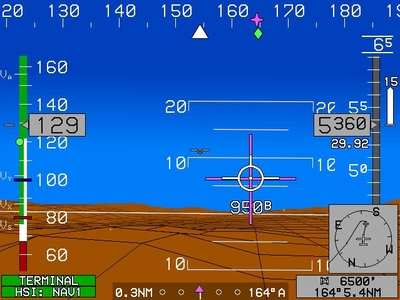Aero-Tips!
A good pilot is always learning -- how many times have you heard
this old standard throughout your flying career? There is no truer
statement in all of flying (well, with the possible exception of
"there are no old, bold pilots.")

Aero-News has called upon the expertise of Thomas P. Turner,
master CFI and all-around-good-guy, to bring our readers -- and us
-- daily tips to improve our skills as aviators. Some of them, you
may have heard before... but for each of us, there will also be
something we might never have considered before, or something that
didn't "stick" the way it should have the first time we memorized
it for the practical test.
Look for our daily Aero-Tips segments, coming each day to you
through the Aero-News Network.
Aero-Tips 09.10.06
Any more, most "serious" IFR airplanes have an autopilot. Move
into the commercial/Part 135 realm and in most cases a functioning,
three-axis autopilot is required for single-pilot operation.
There's absolutely no question autopilots make instrument flying
tremendously safer, by handling the basic chores of aircraft
control when the pilot is busy with other things-like engine
management, approach set-up, or dealing with distractions.

Many autopilots can "couple" to aircraft navigation systems to
safely and precisely fly an instrument approach. More and more I
hear IFR pilots (especially those with airline backgrounds) say
that all IFR approaches should be flown by the autopilot, with the
pilot monitoring the approach and seeing the "bigger picture". I
agree that the pilot needs to be freed from a lot of mental effort
in physically flying the aircraft. What I don't agree with is
depending on the autopilot exclusively to fly all approaches.
I'm an advocate of hand-flying a good percentage of all actual
approaches, so the pilot retains currency. During my tenure as a
FlightSafety Bonanza/Baron instructor, by far the most common
reason a pilot could not pass an Instrument Proficiency Check (IPC)
was an inability to hand-fly an autopilot- or trim-failed approach
to at least Instrument standards. I still see that tendency in the
flight training I continue to provide. This seems to come mainly
from an over-reliance on the autopilot -- the "gear up, autopilot
on" method of flight. I've seen a very wide cross-section of IFR
aviators training several hundred of them instructing over the last
18 years, from little total time to thousands of hours in the
cockpit. A scary percentage came to me without the skills to
survive should their autopilot have failed in low instrument
meteorological conditions (IMC). In fact, the only pilot I trained
in my four years at FlightSafety who could not complete even a VFR
course in a Baron was at the time an active-duty Air Force pilot-so
technique of flight, not just frequency or total of experience, is
a vital component of safety.
I fear current trends of nearly all-time, autopilot-managed
flight makes it less likely the pilot can survive an instrument,
trim or autopilot failure.
I think the best recommendation is a balanced mix. I personally
recommend a rotating regimen of coupled approaches, flight director
(if equipped) approaches, and raw-data (no autopilot, no flight
director) approaches. One-third of all "actual" approaches should
be of each type, to retain skills required for all three, and the
pilot should alternate frequently between techniques so he/she
stays current in all. The less frequently the pilot flies in IMC
(again, in my opinion), more this should be weighted toward
raw-data and flight director approaches, with correspondingly
higher personal weather minima. This is especially important in
most personal aircraft that do not have a back-up autopilot or
electric trim system, so the pilot isn't too dependent on a single
piece of equipment that can (and historically does) fail. The goal
is to provide an acceptable level of safety, so that the pilot is
the redundant feature should he/she be flying an approach with the
autopilot.

Aero-tip of the day: Never let the autopilot
take you somewhere you could not comfortably hand-fly the
airplane.
 ANN's Daily Aero-Term (04.25.24): Airport Rotating Beacon
ANN's Daily Aero-Term (04.25.24): Airport Rotating Beacon ANN's Daily Aero-Linx (04.25.24)
ANN's Daily Aero-Linx (04.25.24) Klyde Morris (04.22.24)
Klyde Morris (04.22.24) Airborne 04.24.24: INTEGRAL E, Elixir USA, M700 RVSM
Airborne 04.24.24: INTEGRAL E, Elixir USA, M700 RVSM Airborne 04.22.24: Rotor X Worsens, Airport Fees 4 FNB?, USMC Drone Pilot
Airborne 04.22.24: Rotor X Worsens, Airport Fees 4 FNB?, USMC Drone Pilot





